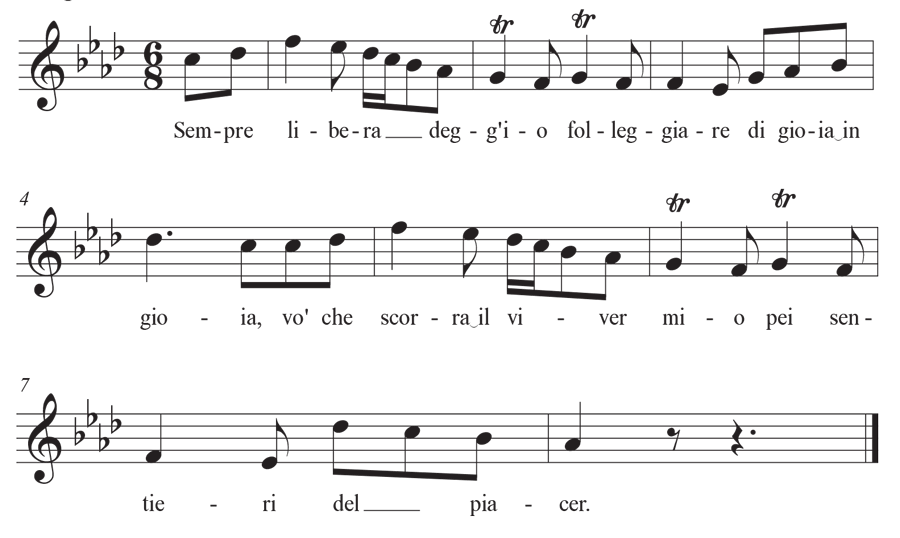Lesson 2: Exploring “Sempre Libera”
| Aim: How do opera singers express emotion with their voices and bodies? Summary: Students explore the ways opera singers express emotion through dramatic musical storytelling, vocal effects, and dramatic gesture. Materials: Musical Explorers CD or online audio Standards: GA: MK-2GM.1, MK-2GM.2, MK-2GM.3, MK-2GM.4, MK-2GM.6, MK-2GM.7, MK-2GM.8, MK-2GM.9, MK-2GM.10 SC: MGK-2.1, MGK-2.3, MGK-2.4, MGK-2.5, MGK-2.6 Vocabulary: ornamentation, trill, melisma |
Learn “Sempre Libera”
- Listen to “Sempre Libera,” Track 14
and ask students if they think it is a dramatic, serious part of the opera or a comedic, funny part of the opera. Why? - “Sempre Libera” (“Always free”) is an aria sung by the character Violetta in the opera La Traviata by Giuseppe Verdi (1813-1901).
- Listen to the pronunciation guide, Track 15
and sing the beginning of “Sempre Libera” with Rebecca, Track 16

Sempre Libera
folleggiare di gioia in gioia,
Vo’ che scorra il viver mio pei
sentieri del piacer.
Nasca il giorno, o il giorno muoia,
Sempre lieta
ne’ ritrovi, ah!
A diletti sempre nuovi dee
volare il mio pensier!
I fly from joy to joy.
I travel along life’s path
however I please.
Whether the day is beginning or ending,
I always want to find
new things to make me happy!
I turn to new delights to
make my spirit fly.
Explore Vocal Ornamentation in “Sempre Libera”
- Opera singing often includes different vocal effects to decorate the song and make it more exciting. We call this vocal ornamentation.
- In “Sempre Libera,” Rebecca sings trills and melismas.
- A trill is a musical ornamentation where you alternate between the main note and the note above very quickly. Practice a trill with Rebecca, Track 17
- A melisma is a group of notes sung on a single syllable. Practice the melisma below with Rebecca,
Track 18
- In “Sempre Libera,” the character Violetta sings about how she loves to be able to do whatever she wants, and how she flies through life looking for things to make her happy. Listen to the aria again. Where are the places where the character sounds happy? Are there any places where she sounds like she’s flying?

Explore Dramatic Gesture in “Sempre Libera”
- As a class, create dramatic movements to illustrate the words and the feelings in the song (e.g., wave your arms like a bird during the melismas; sway back and forth during the beginning of the song).

La Traviata
La Traviata is one of the classic operas of the 19th century, written by one of the greatest opera composers of all time, Giuseppe Verdi (1813-1901). It was first performed in 1853 and is still one of the most performed operas today!
La Traviata is a tragic love story about Violetta and Alfredo. The opera begins with a party at Violetta’s house, where Alfredo tells Violetta that he loves her. Their relationship is complicated—Alfredo’s family does not approve of Violetta, and Violetta does not tell Alfredo that she is very sick. After breaking up, the two reunite and declare their love for each other, but the opera ends tragically when Violetta dies in Alfredo’s arms.
Violetta sings “Sempre Libera” at the beginning of the opera, after Alfredo confesses his love. She is torn between wanting to be free to live her life, and wondering if Alfredo is her true love.
Creative Extension: Create Your Own Opera!
Create an opera as a class. Use one of your class’s favorite stories or movies, and imagine what it would sound like if everyone sang instead of speaking. Challenge your students to create different voices for each character, and different melodies based on different moods.
Musical Word Wall
Add the words ornamentation, trill, and melisma to the Musical Word Wall.
PDF Downloads
SG16 ↓ Download File
Musical Explorers Audio Tracks
